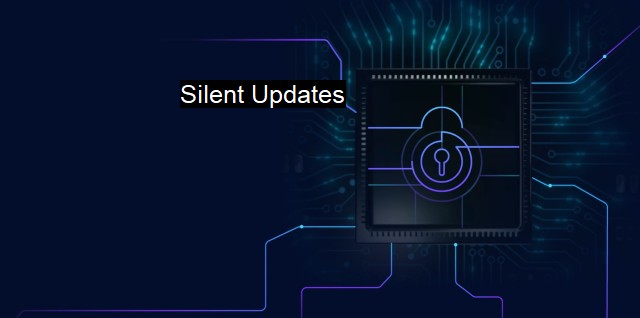What are Silent Updates?
Exploring the Benefits and Advantages of Silent Updates in Cybersecurity and Antivirus Software Vulnerabilities
Silent updates are a significant aspect in the realm of cybersecurity and antivirus software. Distinct from the traditional updates that commonly necessitate user intervention for installation, silent updates are automatically deployed and apply changes to software, without the explicit permission, or sometimes even the knowledge, of the user.In the cybersecurity domain, silent updates tackle an underlying issue by enabling automatic and real-time upgrades to antivirus software. Concerning antivirus software, their main objective is safeguarding your personal computer or servers against threat actors such as viruses, malware, or spyware. to maintain effective protection, this software must stay current with ever-emerging, evolved threats. Hence, silent updates prove immensely beneficial in continuously adapting the software to counter new cybersecurity threats.
The increasing levels of cybercrime necessitate consistent, ongoing updates to protect against new exploits and vulnerabilities. Malicious actors are continually seeking ways to penetrate defenses, creating sophisticated malware designed to bypass or exploit out-of-date security software. Without silent updates, the delay between the point of vulnerability discovery and user-applied patch could provide these criminals with the time they need to infiltrate systems successfully. By running silent updates, antivirus software aims to minimize this window of opportunity, maintaining an advanced state of protection.
The primary advantage of silent updates lies in the continuous, automated protection it provides, negating the necessity for user know-how or intervention. Users unknowingly forget, ignore, or delay updates due to various reasons such as busy schedules or limited technical competence. Hence, the advantage of using silent updates is that there is less reliance on the actions of the end user, limiting the risk of human error. Even without extensive computer skills or an in-depth understanding of antivirus software, users remain protected as their systems stay automatically updated.
Since these updates occur 'silently,' they do not disrupt the user's tasks or impact system performance significantly. Hence, users can carry on with their work or leisure activities without the botheration of system slowdowns or intrusive installation prompts.
Nonetheless, silent updates are accompanied by certain drawbacks. Users often appreciate the authority to know and exert control over what changes take place within their systems. Silent updates subvert this authority as they are installed without explicit user consent. This can result in potential trust issues, leading to reservations about data privacy and security. in rare instances, updates may unintentionally introduce bugs or glitches that disrupt the user's system.
To strike a balance, some software utilizes a compromise approach by informing users about pending updates or changes via non-intrusive notifications, thereby providing some level of transparency without hampering the user experience or activities.
In a context where cyber threats and malware are ever-evolving and increasingly sophisticated, silent updates perform a critically vital function. Regardless of the associated potential for suspicion or mistrust, the capability of silent updates to maintain a potent defense against cyber attacks proves to be a vital attribute.
Silent updates in cybersecurity and antivirus software exemplify the frequently unseen war against cybercrime. They silently shield users from malicious threats, restricting the opportunity for breaches, securing data, and ensuring smooth, unimpeded computing experiences.

Silent Updates FAQs
What are silent updates in cybersecurity?
Silent updates refer to updates that are installed automatically without the user's knowledge or intervention. They are meant to improve the functionality and security of software and operating systems without disrupting the user’s workflow.How are silent updates useful for antivirus software?
Silent updates for antivirus software allow the software to stay up-to-date with the latest virus definitions and security patches. This ensures that the antivirus software is able to protect your system against the latest threats and vulnerabilities without requiring manual intervention from the user.Can users disable silent updates for antivirus software?
In general, it is not recommended to disable silent updates for antivirus software as this can leave your system vulnerable to security threats. However, some antivirus software may provide the option to disable silent updates for users who require more control over the update process.Are silent updates safe for cybersecurity?
Silent updates are generally considered safe for cybersecurity as they are designed to improve the security and functionality of software while minimizing disruption to the user. However, it is important to ensure that the updates come from a trusted source, as there is a risk of malicious actors using silent updates to install malware or other harmful software on your system. It is recommended to keep your antivirus software and operating system updated with the latest security patches and updates to ensure maximum protection against cybersecurity threats.| | A | | | B | | | C | | | D | | | E | | | F | | | G | | | H | | | I | | | J | | | K | | | L | | | M | |
| | N | | | O | | | P | | | Q | | | R | | | S | | | T | | | U | | | V | | | W | | | X | | | Y | | | Z | |
| | 1 | | | 2 | | | 3 | | | 4 | | | 7 | | | 8 | | |||||||